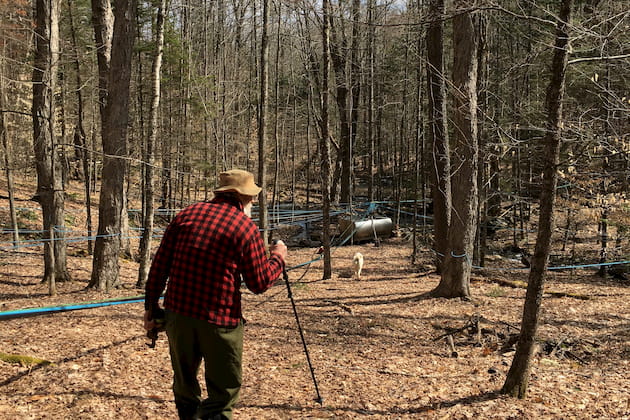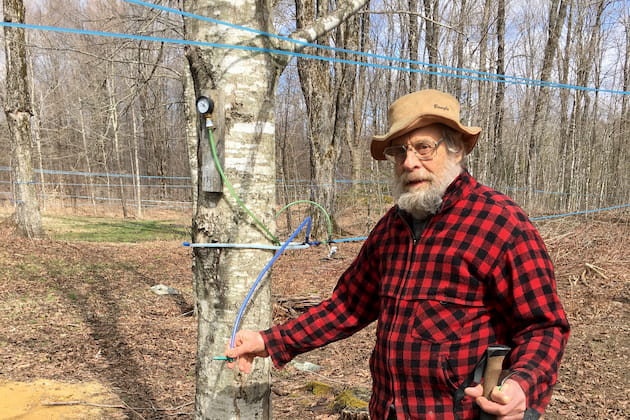Tapping & Tubing
Sugarmaker shares experiences with 3/16 sanitation
Art Krueger is 3/16 pioneer in Vermont
By ART KRUEGER | SEPTEMBER 3, 2020
SHREWSBURY, Vt.—My family’s sugarhouse finally made some significant breakthroughs using 3/16 tubing.
We managed to completely empty our woodshed of 30 cords and needed to scrounge several cords more to finish up. Certainly a measure of success since, after all, emptying the woodshed is the real objective.
Additionally, we’ve had our best year ever reversing the disappointing trend of the past several years.
We’ve even had to sell over 5000 gallons of sap to a neighbor as we were not able to boil it down fast enough.
WHAT WE DID
We bleached our entire network with calcium bleach at a concentration of 400 ppm (a 1 pound packet of Zappit to 200 gallons of warer) as we detapped last spring.
We pumped this up from the bottom of the system.
We made sure each drop was filled with bleach solution, then plugged it off.
The calcium bleach degrades to lime over the summer.
We rinsed most of it in the fall and let a very small amount of sap run on the ground this spring to complete the cleaning. I do believe that leaving the solution in all summer deters squirrels, as the resulting lime solution has a bitter taste.
The only squirrel damage we had before the start of the season was in the new 5/16” drops.
We also changed drops and tees and spouts on all of the lines feeding one of our tanks.
We used 5/16” drops with Zap-Bac silver spouts, and D&G 5/16” x 3/16” x 3/16” tees. (Note that the studs on these tees did not fit the silver spouts. It is not possible to plug these spouts with these tees.)
We only did this on the sugar maples. The 5% or so of red maples in this section were left with old spouts, the theory being it might be beneficial to have these quit early by taking advantage of bacterial growth.
We also installed 2 completely new lines, one with new 3/16” drops with D&G spouts and one with 5/16” drops with silver spouts as a check.
THE RESULTS
The first sap of the season was the cleanest I’ve ever seen, clear as our spring water. It made some very nice syrup.
Clogging was nonexistent in the lines with the 3/16” drops.
We experienced severe clogging in 4 of the 21 lines with the 5/16” drops and silver spouts. This did not occur until late March, a month after the sap started flowing. It only occurred in the lower sections of the lines, several hundred feet below the lowest drop.
It was not associated with joints but occurred in the tubing itself. I have no idea why this happened. I believe that in the previous years, clogging was a long and persistent problem in the network.
Overall, we got 0.3 gallon of syrup per tap. This suggests that there is considerable room for future improvement, but it is about twice the rate we produced in the previous 2 years.
For the first month all parts of the bush produced very well. We intended to keep track of what the various parts of the system did, but sap flow was so intense that we soon lost track - a veritable sapnami.
We were averaging about 2000 gallons from 2400 taps each day the sap flowed. In the last week of the season the sap flow slowed enough so that we could see some differences that were not present in the beginning of the season.
On the last day that we had our network up we got excellent flow in both of the new lines. We also got excellent flow in some but not all of the 5/16” drops with the silver spouts, but sap flow had diminished considerably in the rest of the system.
Over the last 3 days of flow we got 300 gallons from the section with silver spouts (21% of the bush) and 300 gallons from the remaining 79%.
If the rest of the bush did as well as the silver spouts, our total sap production for that period would have been about 1400 gallons instead of 600, and we might have continued collecting sap a little longer. We would have probably gotten 50 gallons more of syrup during the last week of the season.
In previous years I have tried many replacement strategies in my network. They were all a waste of time and money. This trial with the 5/16” drops and silver spouts is the first time any one of them has worked.
I don’t believe this would have worked though without bleaching on the 3/16” laterals.
In my bleaching technique on the 3/16” drops I was able to bleach the drops and the inside of the spouts but was not able to bleach the outside of the spouts. I think this led to the dwindling of the production in the last week in those areas.
The silver spouts being both new and bacterial static stopped this. I believe if I can find a way to bleach the outside of the spouts I might achieve good results throughout, as bleaching for at least 30 minutes has been found to be very effective by both Proctor and Cornell. The science is very strong here.
NEXT YEAR
One way to proceed would be to do the entire bush, excepting the red maples, with 5/16” drops and silver spouts. But it takes $1 in material and about $1.50 in labor per drop to do this, and there are about 1700 more drops to do.
The math is quite discouraging. If I was going to do a completely new installation though, I certainly would consider this.
Another way to proceed would be to try new 3/16” silver spouts on my existing 3/16” drops. This is much cheaper and not very labor intensive.
A third way would be to do a better job of bleaching the outside of the spouts.
I will use the Stericaps used by Canadians in their isopropyl alcohol cleaning system to do this. (Of course I’m using bleach instead of alcohol.) This is the cheapest in both money and labor. I have ordered 2200 from LaPierre.
Beaching is not very difficult if it is done while detapping and if you are well organized.
It certainly is a lot easier than changing drops! I have made 2 youtube videos describing this. I had hoped to have a workshop here on it this spring but with the coronavirus this is now impossible; maybe next year.
One issue I have found is that we can’t tell how effective our cleaning technique has been until the following year.
There is a better way.
The Province of Ontario has been lending luminometers to its sugarmakers to determine how effective their cleaning strategies were.
It would be helpful if other jurisdictions did the same, as they are a bit pricey.
One issue I have found is that we can’t tell how effective our cleaning technique has been until the following year. There is a better way, a luminometer. Evidently you take a swab of the tubing, add a reagent, and stick it in the luminometer. It then tells you how much contamination you have.
Both Proctor Research Center and Cornell did the original research on using bleach in tubing sanitation and have been very helpful. I am indebted to both of these fine institutions for getting me started on this journey.

































